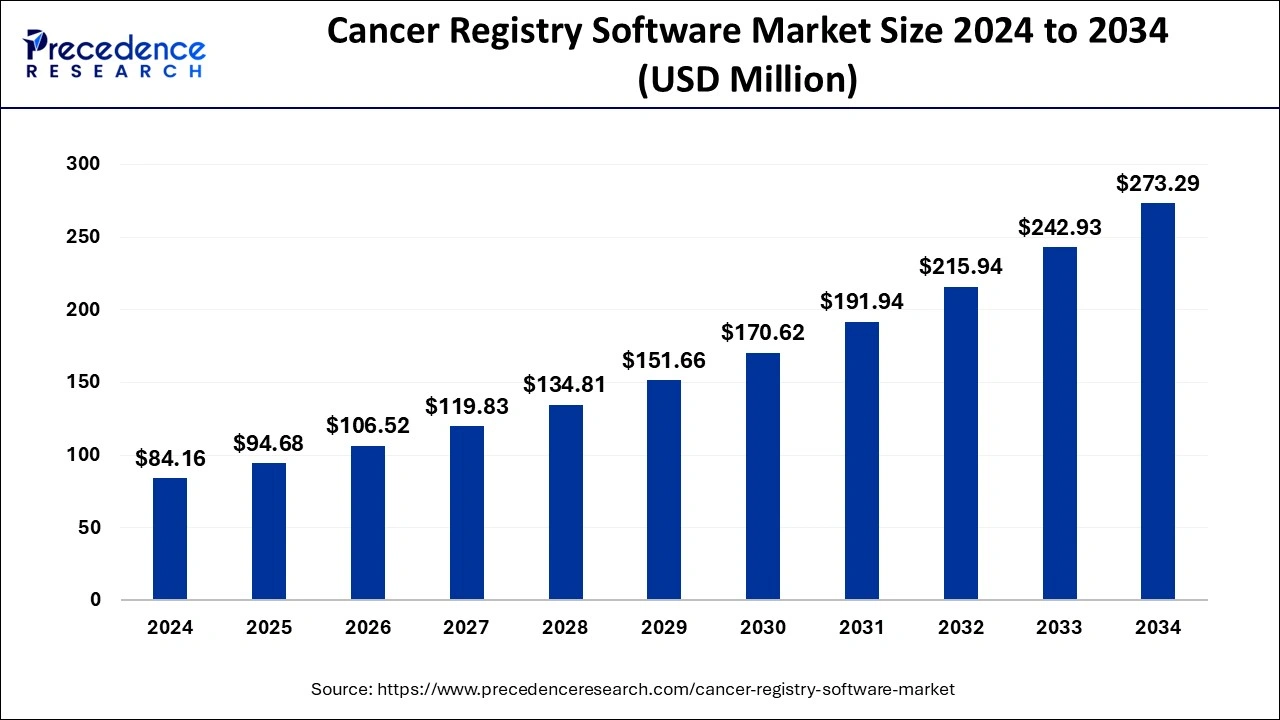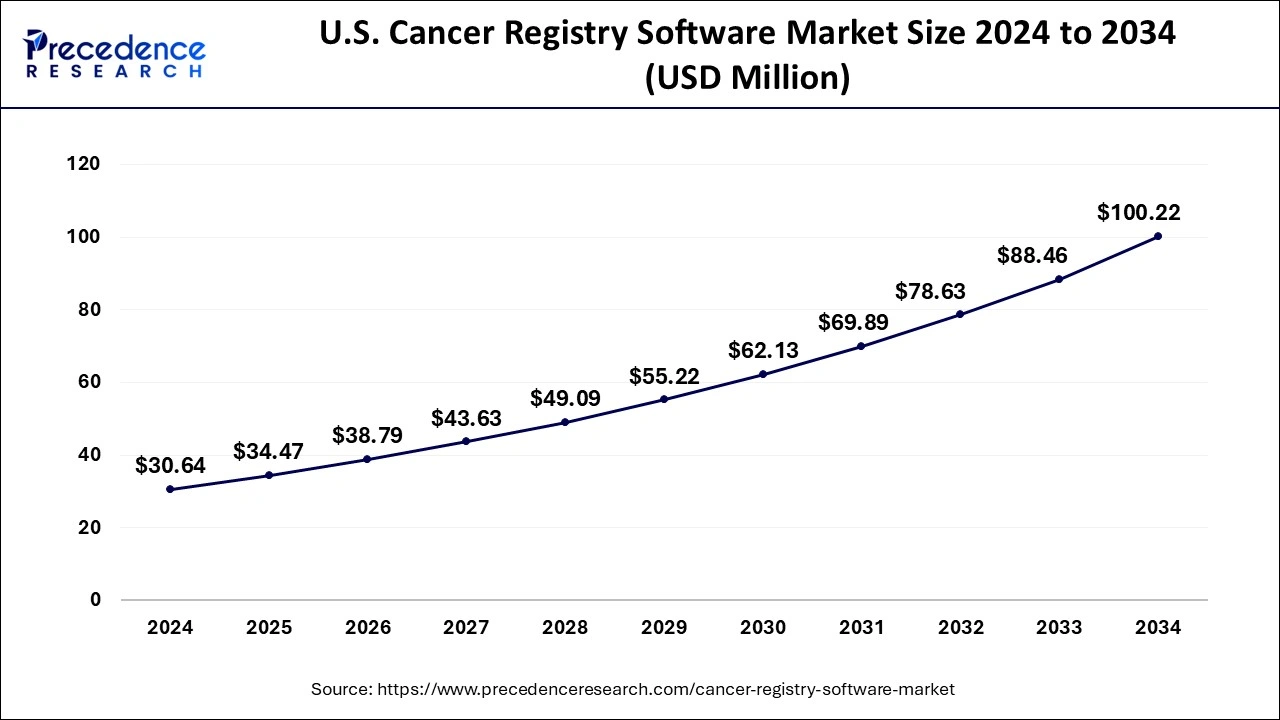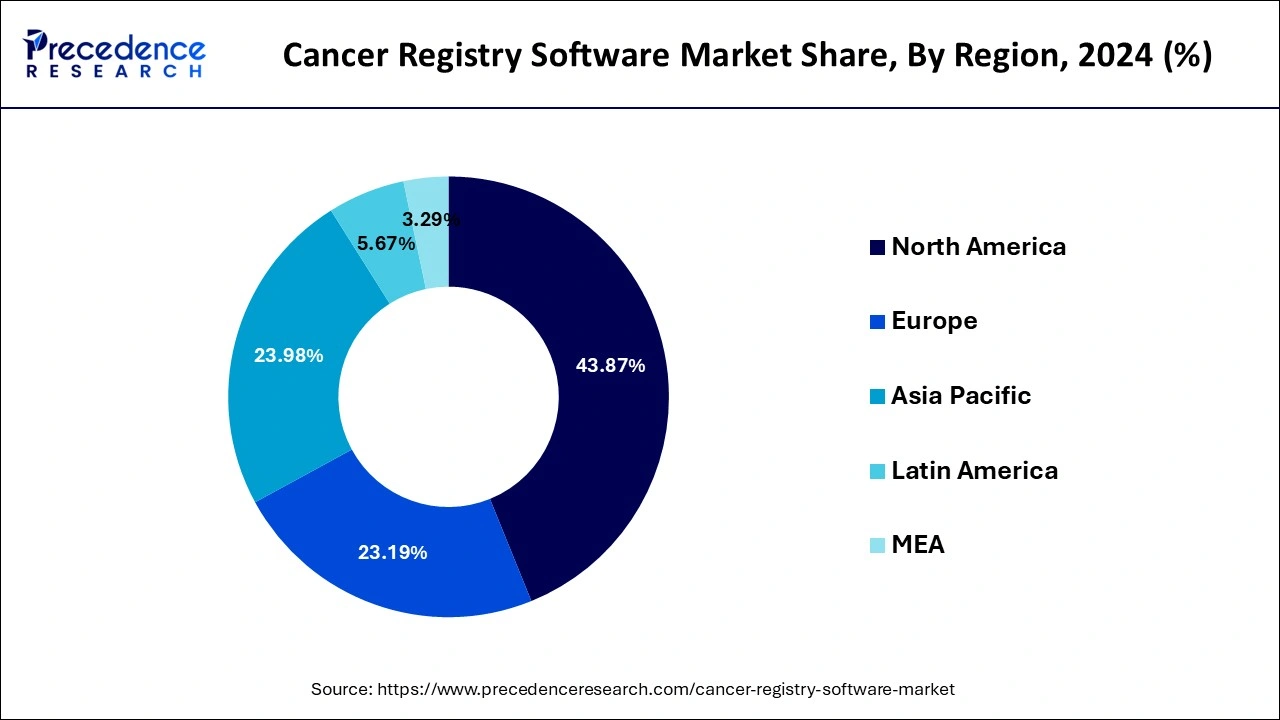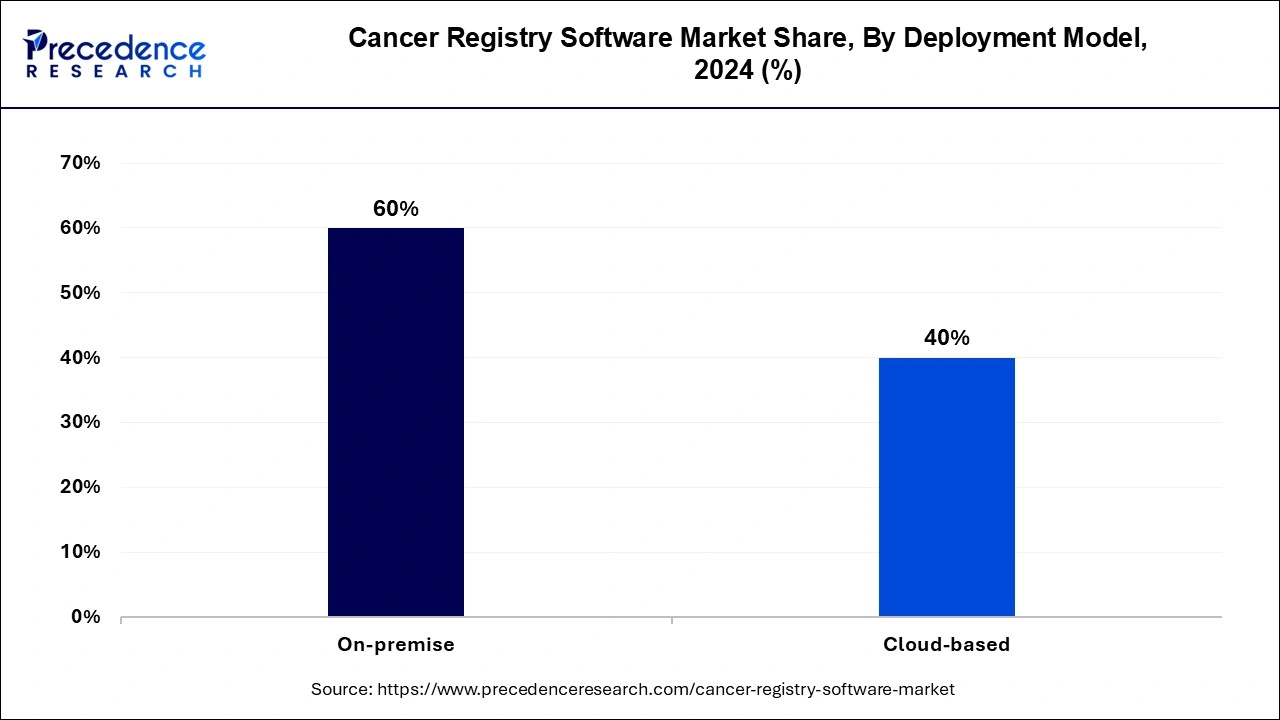January 2025
The global cancer registry software market size was accounted for USD 84.16 million in 2024, grew to USD 94.68 million in 2025 and is predicted to surpass around USD 273.29 million by 2034, representing a healthy CAGR of 12.50% between 2025 and 2034. The North America cancer registry software market size was calculated at USD 36.92 million in 2024 and is expected to grow at a fastest CAGR of 12.51% during the forecast year.
The global cancer registry software market size was estimated at USD 84.16 million in 2024 and is anticipated to reach around USD 273.29 million by 2034, expanding at a CAGR of 12.50% from 2025 to 2034.

Using artificial intelligence (AI) techniques to process, enhance and integrate cancer registry data to make oncology and research security easier than ever. The relative advantages of AI over traditional methods. The traditional cancer registry process is time-consuming and prone to human error. The AI cancer registry automation module revolutionizes registry operations with a seamless end-to-end solution that automates data collection, analysis and reporting.
The U.S. cancer registry software market size was evaluated at USD 30.64 million in 2024 and is predicted to be worth around USD 100.22 million by 2034, rising at a CAGR of 12.58% from 2025 to 2034.

North America dominated the cancer registry software market with the largest market share of 43.87% in 2024. The U.S. dominated the cancer registry software market in North America region. The North America region has presence of major market players operating in the cancer registry software market. The cancer registry software market in this region is growing due to the rising prevalence of cancer. In addition, due to high investments in the technology, the demand for cancer registry software is rising on a large scale in North America.

Asia-Pacific is expected to expand at a double digit CAGR of 14.5% during the forecast period. The government of emerging nations such as Japan and China are taking constant efforts for the development of the cancer registry software market. Moreover, the key market players are collaborating with the government agencies for the expansion of the healthcare sector. This factor is driving the growth of the cancer registry software market in Asia-Pacific region.
| Report Coverage | Details |
| Market Size in 2024 | USD 84.16 Million |
| Market Size in 2025 | USD 94.68 Million |
| Market Size by 2034 | USD 273.29 Million |
| Growth Rate from 2025 to 2034 | CAGR of 12.50% |
| Largest Market | North America |
| Base Year | 2024 |
| Forecast Period | 2025 to 2034 |
| Segments Covered | By Software, By Deployment Model, By Component, By End User, and By Functionality |
| Regions Covered | North America, Europe, Asia-Pacific, Latin America, and Middle East & Africa |
Enhanced Capabilities of Cancer Registry Software
The ability of the cancer registry to expand its processes for additional data collection, training, development, and electronic reporting drives the growth of cancer registry software market. This system is important because it supports the comparative effectiveness of research and makes the improvement of public health and research data more efficient. Cancer registries provide a census of cancer patients and enable cancer to be tracked at regional, state, and national levels. In addition, they can investigate cancer treatment patterns and evaluate public health measures to prevent cancer and improve survival, driving demand for advanced cancer treatment software solutions.
Advancements in Cloud-Based Cancer Registry Systems
The new cloud computing system developed by the national cancer registry program (NPCR) for the central cancer registry presents a significant opportunity in the cancer registry software market. This development, currently being, allows for increased collection, aggregation, and storage of cancer data. With real-time data access, the Central Cancer Registry can quickly access and analyze cancer data, allowing for faster submission of data to the CDC. Automating activities in the system will increase the accuracy, completeness, and timeliness of information. Additionally, the potential for collaboration between NPCR and other organizations to develop additional capabilities creates additional opportunities for innovation and growth in the cancer registry software market.
Challenges in Cancer Registry Data Management and Compliance
Many healthcare organizations face significant challenges in managing timely referrals and cancer follow-up, particularly due to limited access to oncology data specialist certified (ODS-C). Additionally, fragmentation of cancer data across multiple systems and aggregation in medical records due to manual and EMR access impacts data management. Additionally, not every organization needs a complete solution, as each organization has unique needs, and changes may impact their needs over time. These factors have limited the growth of the cancer registry software market as they hinder the integration and development of software solutions.
The standalone segment dominated the cancer registry software market in 2024. The standalone cancer registry software is integrated with latest and advanced features. It is also easy to use and operate. The standalone cancer registry software also helps in the reduction of overhead costs. Thus, all of these factors are propelling the growth of the segment.
The integrated segment is expected to witness strong growth during the forecast period. The integrated cancer registry software helps to collaborate with the hospitals’ software. This software helps to locate patients in any location. The integrated cancer registry software also assists to track and monitor the health of patients.
The on-premise segment accounted for the highest market share of 60% in 2024. The on-premise cancer registry software is mostly adopted by research institutes who are doing research on cancer. The on-premise cancer registry software is embedded with advanced features which help to store data easily. The on-premise cancer registry software is less risky as compared to other types of models. Thus, the on-premise cancer registry software is widely used in hospitals and research centers.

The cloud-based segment is projected to grow at a solid CAGR of 13.2% during the forecast period. The cloud-based cancer registry software can be integrated with the real time data and standard guidelines. This software helps in the reduction of information technology overhead costs. In addition, the cloud-based cancer registry software is efficient in nature, which is driving the growth of the segment.
The commercial segment has held the biggest market share of 76% in 2024. The data stored in the commercial database is quite safe as compared to public database. The data stored in the commercial database can be easily tracked. The commercial database can be used across research centers and government agencies. Thus, the commercial segment is rising at a rapid pace.
The public segment is registering a remarkable CAGR of 13.54% during the forecast period. The public database is used for the various cancer research programs. The utilization of public database is growing due to the growing number of research centers all over the globe. The public database can help to track patient data from any corner of the world.
The government & third-party segment contributed the maximum market share of 28% in 2024. The government of established and emerging nations is adopting cancer registry software on the large scale. This software helps to track and monitor cancer patients in their respective region. In addition, the investments made by government for the implementation of cancer registry software in hospitals. This factor is boosting the growth of the global cancer registry software market over the forecast period.
The research institutes segment is projected to grow at a solid CAGR of 13.24% during the forecast period. The cancer registry software is widely used in research institutes due to growing prevalence of cancer. The growing research and development initiatives by biotechnology and pharmaceutical industry players are also driving the growth of the global cancer registry software market.
By Software
By Deployment Model
By Component
By End Use
By Functionality
By Geography
For inquiries regarding discounts, bulk purchases, or customization requests, please contact us at sales@precedenceresearch.com
No cookie-cutter, only authentic analysis – take the 1st step to become a Precedence Research client
January 2025
September 2024
September 2024
October 2024